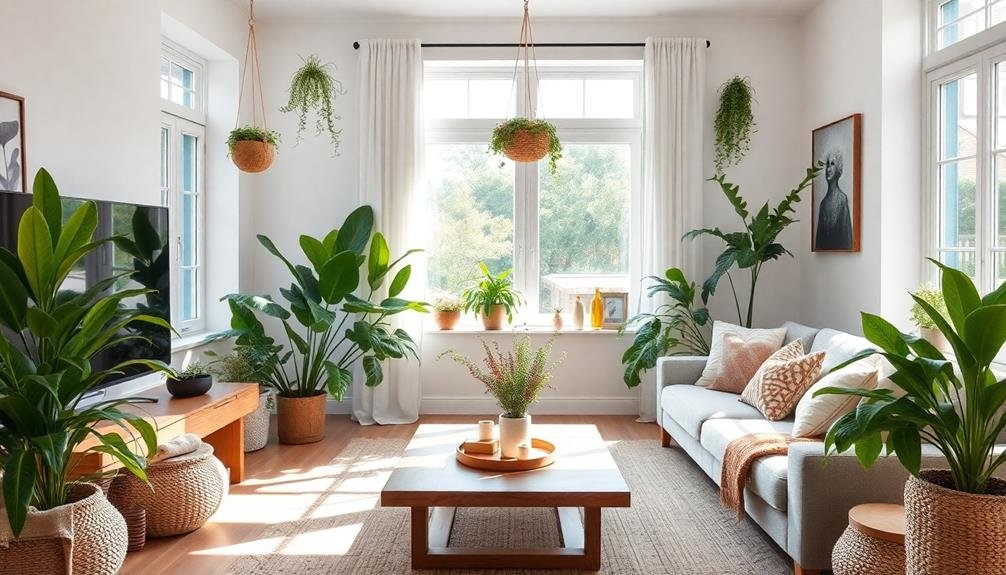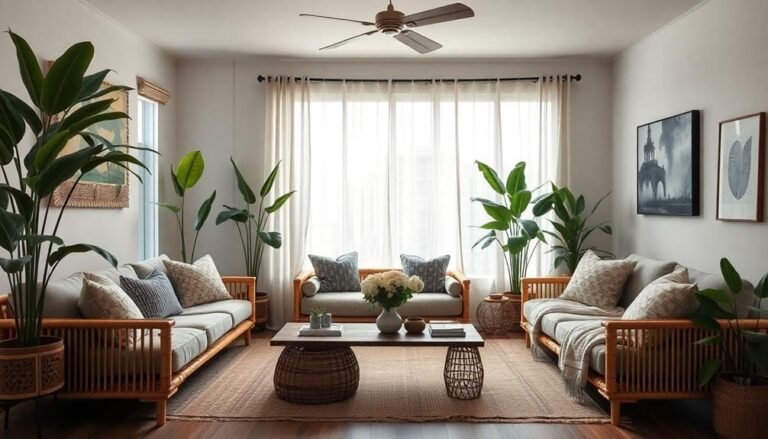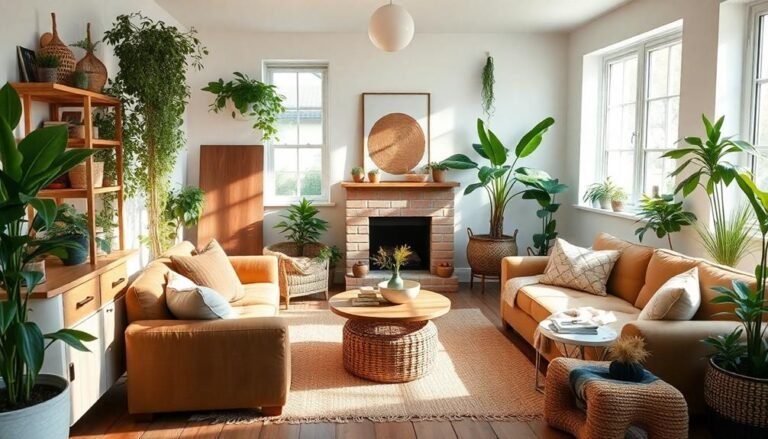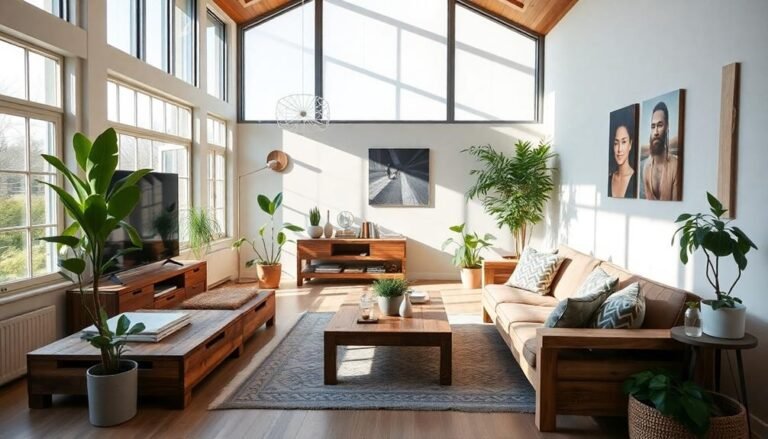Decorating with plants can truly bring nature indoors while creating a sustainable environment. By adding greenery, you not only enhance your space but also purify the air and boost your mood. Choose plants that fit your home's light and humidity levels, like snake plants for low light or ferns for high humidity areas. Creative arrangements, such as grouping plants in odd numbers or using diverse containers, can add character to any room. Sustainably caring for these plants, like using rainwater and native species, further enhances their impact. Discovering the right plants can transform your living space beautifully.
Benefits of Indoor Plants
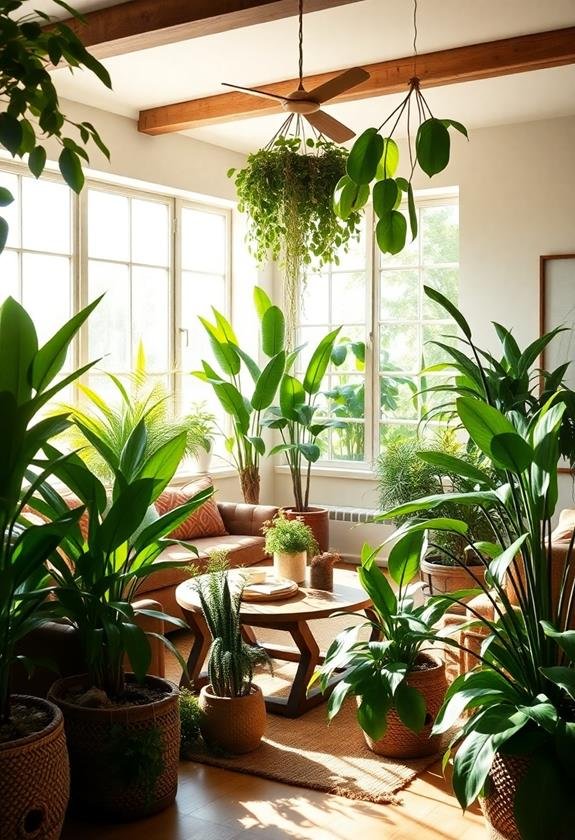
Indoor plants offer a wealth of benefits that can transform your living space and enhance your well-being. One of the most significant advantages is their ability to purify the air. Plants like spider plants and peace lilies absorb toxins and release oxygen, creating a healthier environment for you to breathe. In fact, studies have shown that certain indoor plants can filter pollutants by up to 87% in just 24 hours, showcasing their effectiveness in air purification top air purifiers. Imagine coming home to a space filled with fresh air, promoting relaxation and a sense of serenity.
Additionally, indoor plants can boost your mood and productivity. Studies show that having greenery around can reduce stress levels and increase focus. When you're surrounded by vibrant foliage, you may find yourself feeling more energized and motivated to tackle your daily tasks.
Moreover, nurturing plants can provide a sense of accomplishment. As you watch them grow and thrive, you'll develop a deeper connection with nature, which can be incredibly fulfilling. Think of it as having a little piece of the outdoors in your home, bringing joy and peace.
Lastly, indoor plants can enhance your decor, adding beauty and warmth to any room. Whether you choose a striking monstera or a delicate fern, these plants can serve as eye-catching focal points, making your space feel more inviting and alive.
Choosing the Right Plants
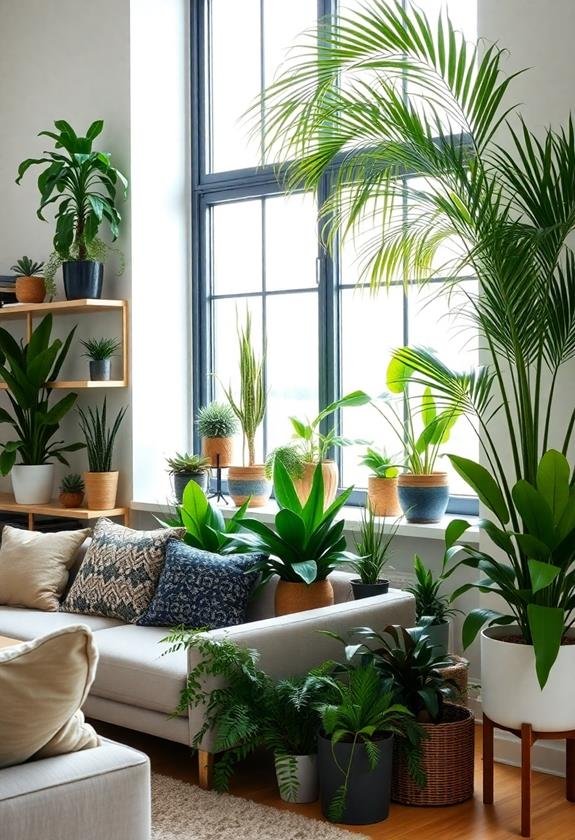
When selecting plants for your space, consider factors like light conditions, humidity, and the level of care you can provide. Start by evaluating how much natural light your area receives. If you have bright, direct sunlight, you might embrace sun-loving plants like succulents or cacti. Conversely, if your space is low on light, opt for hardy varieties like snake plants or pothos, which thrive in indirect light. For those who prefer a more maintenance-free option, low-maintenance artificial plants can also enhance your decor without the upkeep of live plants.
Next, think about humidity levels. If you live in a dry climate or have central heating, you'll want plants that can tolerate those conditions, such as ZZ plants or rubber trees. On the other hand, if you have a naturally humid environment, consider tropical plants like ferns or peace lilies that flourish in such settings.
Creative Plant Arrangements
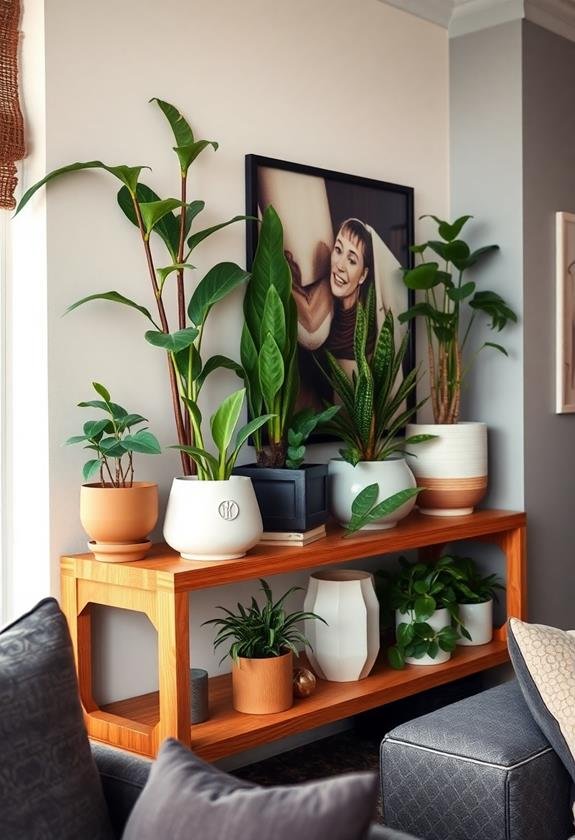
Arranging plants creatively can transform your space, adding layers of texture and visual interest. Start by considering height variations; mix tall, spiky plants like snake plants with trailing vines such as pothos. This contrast creates depth and draws the eye. Grouping plants in odd numbers, like threes or fives, often feels more natural and visually appealing than even-numbered arrangements. For those looking to enhance their indoor environment, real indoor plants can be a perfect choice.
You might also want to experiment with different containers. Using a combination of ceramic pots, woven baskets, and even recycled jars can add character. Don't hesitate to play with color, too—choose pots that complement your room's palette or provide a bold contrast to make a statement.
Creating a themed display can be fun as well. For instance, you could curate a "desert oasis" with succulents and cacti, or a "tropical getaway" using ferns and palms. Incorporating decorative elements like stones or driftwood can enhance these themes further.
Sustainable Plant Care Tips
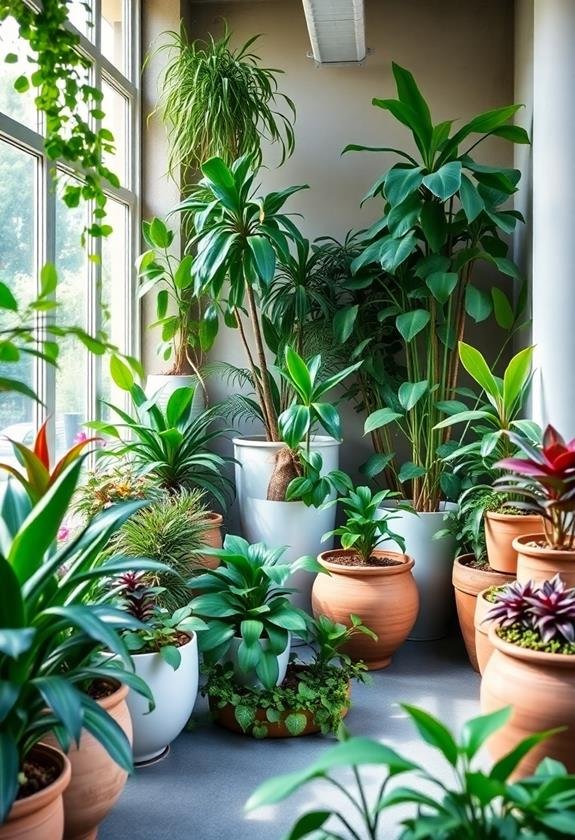
Sustainable plant care is all about nurturing your green friends while minimizing your environmental impact. To start, choose native plants that thrive in your climate, reducing the need for excessive watering and fertilizers. When it comes to watering, always check the soil moisture first; overwatering can harm plants and waste water. Use rainwater or leftover water from cooking to hydrate your plants—this not only conserves resources but also makes use of what you already have.
Fertilizing sustainably involves using organic compost or homemade fertilizers, which enrich the soil without the harmful effects of chemical additives. Avoid synthetic pesticides, as they can harm beneficial insects; instead, consider natural remedies like neem oil or insecticidal soap to protect your plants.
Don't forget about repurposing! Use old containers for planting, or propagate your plants to share with friends. This way, you reduce waste while spreading the joy of greenery. Finally, regularly check for pests and diseases; early detection can save your plants and limit the use of treatments. By following these sustainable plant care tips, you'll promote a healthier environment, and your indoor garden will thrive beautifully.
Enhancing Room Aesthetics

Adding plants to your space not only supports a sustainable lifestyle but also enhances room aesthetics in remarkable ways. When you introduce greenery, you instantly breathe life into your environment. Consider how a tall fiddle leaf fig can create a striking focal point in a living room, drawing the eye upward and adding dimension. Smaller plants, like succulents or pothos, can effortlessly fill empty corners or adorn shelves, making your space feel more inviting.
The colors and textures of various plants can complement your existing décor, creating a harmonious atmosphere. For instance, vibrant green leaves contrast beautifully with neutral tones, while flowering plants add splashes of color that can enliven a room. You might find that placing a few well-placed plants enhances your mood, making your space feel more serene and connected to nature.
Additionally, the varying shapes and sizes of plants provide an organic contrast to hard lines and structures in your home. By experimenting with different arrangements and placements, you can discover how plants can transform your space into a visually appealing sanctuary that reflects your personality and style. So, don't hesitate—let nature's beauty thrive indoors.
Incorporating Plants in Every Room
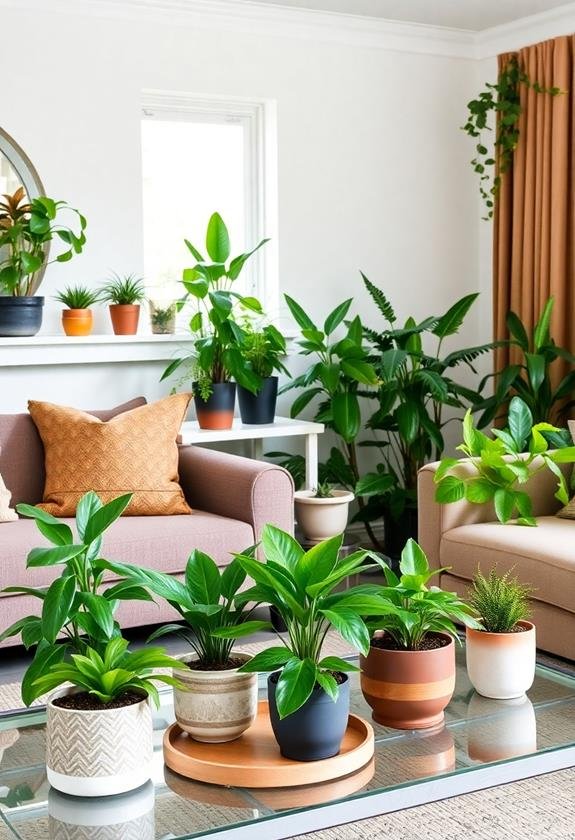
Every room in your home can benefit from the lively touch of plants. In the living room, consider placing a tall snake plant in a corner, which not only adds height but also purifies the air. In the kitchen, small herb pots on the windowsill can provide fresh ingredients for your meals while enhancing the space with greenery.
For your bedroom, opt for a peace lily; its soft, white blooms add elegance while improving air quality. A small succulent on your nightstand requires minimal care and brings a sense of calmness.
In the bathroom, humidity-loving plants like ferns thrive, making them an ideal choice to create a spa-like atmosphere. Finally, don't forget the home office; a desk plant, such as a pothos, can boost your mood and productivity.
Frequently Asked Questions
How Can I Ensure My Indoor Plants Thrive Long-Term?
You'd think keeping indoor plants alive is as simple as watering them, right? Well, it's a bit more nuanced. To guarantee your plants thrive long-term, you need to provide the right light, moisture, and nutrients. Regularly check the soil's moisture level, and adjust your watering schedule accordingly. Also, rotate your plants occasionally to promote even growth. Finally, don't forget to prune dead leaves, allowing your plants to flourish beautifully and healthily.
What Are the Best Plants for Low-Light Environments?
If you're looking for the best plants for low-light environments, consider options like snake plants, pothos, and ZZ plants. These hardy varieties thrive in lower light conditions, making them perfect for dimly lit rooms. Snake plants, for example, can tolerate neglect and only need watering when the soil is dry. Pothos, with its trailing vines, adds a touch of greenery while being incredibly easy to care for. Choose these plants, and you'll enjoy a thriving indoor garden.
Are There Specific Plants That Improve Air Quality?
You might think your air quality's just fine, but did you know certain plants can help? Spider plants, peace lilies, and snake plants are your go-to air-purifiers. They absorb toxins like formaldehyde and benzene, improving the air you breathe. Plus, they're low-maintenance! So, if you want fresher air without breaking a sweat, consider adding these green friends to your space. Your lungs will thank you, and your home will feel more inviting!
How Often Should I Water My Indoor Plants?
You should water your indoor plants based on their specific needs, which can vary widely. Generally, it's best to check the top inch of soil; if it feels dry, it's time to water. Most plants prefer a thorough soaking, allowing excess water to drain out. Remember, overwatering can be just as harmful as underwatering. Keeping a consistent schedule, like once a week, can help, but adjust according to your plant's moisture requirements.
Can Houseplants Help With Allergies or Respiratory Issues?
Imagine your home as a sanctuary, where fresh air flows freely. Houseplants can indeed help with allergies and respiratory issues. They filter out harmful pollutants, such as formaldehyde and benzene, while increasing humidity, which can soothe irritated airways. For instance, spider plants and peace lilies are known for their air-purifying qualities. By strategically placing these plants in your space, you're not just beautifying your home; you're promoting a healthier environment for yourself.

